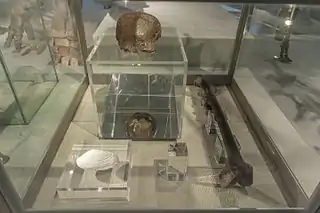Trinil
Trinil is a palaeoanthropological site on the banks of the Bengawan Solo River in Ngawi Regency, East Java Province, Indonesia. It was at this site in 1891 that the Dutch anatomist Eugène Dubois discovered the first early hominin remains to be found outside of Europe: the famous "Java Man" (Homo erectus erectus) specimen.[3][4][5]

Trinil
Trinil (Indonesia)
.jpg.webp)
This Homo Erectus shell with geometric incisions, dated to circa 500,000 BP, has been claimed as the first known work of art. From Trinil, Java. Now in the Naturalis Biodiversity Center, Netherlands.[1][2]

References
- Callaway, Ewen (2014). "Homo erectus made world's oldest doodle 500,000 years ago". Nature News. doi:10.1038/nature.2014.16477.
- Brahic, Catherine (3 December 2014). "Shell 'art' made 300,000 years before humans evolved". New Scientist. Retrieved 29 September 2018.
- http://humanorigins.si.edu/evidence/human-fossils/fossils/trinil-2%5B%5D
- Turner W (April 1895). "On M. Dubois' Description of Remains recently found in Java, named by him Pithecanthropus erectus: With Remarks on so-called Transitional Forms between Apes and Man". Journal of Anatomy and Physiology. 29 (Pt 3): 424–45. PMC 1328414. PMID 17232143.
- Hepburn D (October 1896). "The Trinil Femur (Pithecanthropus erectus), contrasted with the Femora of Various Savage and Civilised Races". Journal of Anatomy and Physiology. 31 (Pt 1): 1–17. PMC 1327807. PMID 17232222.
Further reading
- Hooijer, Dirk A.; Kurtén, Björn (1984). "Trinil and Kedungbrubus: the Pithecanthropus-bearing fossil faunas of Java and their relative age". Annales Zoologici Fennici. 21 (2): 135–41. JSTOR 23734854.
- Jacob, Teuku (1973). "Palaeoanthropological discoveries in Indonesia with special reference to the finds of the last two decades". Journal of Human Evolution. 2 (6): 473–8, IN5–IN11, 479–85. doi:10.1016/0047-2484(73)90125-5.
This article is issued from Wikipedia. The text is licensed under Creative Commons - Attribution - Sharealike. Additional terms may apply for the media files.